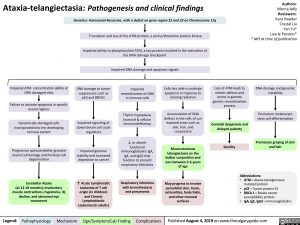Ataxia-telangiectasia: Pathogenesis and clinical findings Genetics: Autosomal Recessive, with a defect on gene region 22 and 23 on Chromosome 11q
Authors: Merna Adly Reviewers: Kara Hawker Crystal Liu Yan Yu* Laurie Parsons* * MD at time of publication
Truncation and loss of the ATM protein, a serine/threonine protein Kinase
Impaired ability to phosphorylate ATM, a key protein involved in the activation of the DNA damage checkpoint
Impaired DNA damage and apoptosis signals
Impaired ATM concentration ability at DNA damaged sites
Failure to activate apoptosis in specific neural regions
Genomically-damaged cells incorporated into the developing nervous system
Progressive spinocerebellar granular neural cell damage and Purkinje Cell degeneration
Cerebellar Ataxia
(at 12-18 months); involuntary muscle contractions, hypotonia, IQ decline, and abnormal eye movement
Loss of ATM leads to mitotic defects and arrest in gamete genetic recombination process
Gonadal dysgenesis and delayed puberty
DNA damage to tumor suppressors such as p53 and BRCA1
Impaired signaling of downstream cell cycle regulators
Impaired genome stability and increased disposition to cancer
↑ Acute Lymphocytic Leukemia of T cell origin (in children) and Chronic Lymphoblastic Leukemia (in adults)
Impaired recombination of DNA in immune cells
Thymic hypoplasia; humoral & cellular immunodeficiency
↓ or absent functional immunoglobulins IgA, IgE, and IgG2 that function to prevent respiratory infections
Respiratory infections with bronchiectasis and pneumonia
Cells less able to undergo apoptosis in response to ionizing radiation
Accumulation of DNA defects in the cells of sun exposed areas such as skin, hair, and conjunctiva
Mucocutaneous telangiectasia on the bulbar conjunctiva and ears between 2-6 years of age
May progress to involve periorbital skin, trunk, extremities, body folds, and other mucosal surfaces
Sterility
DNA damage and genomic instability
Premature melanocyte stem cell differentiation
Premature graying of skin and hair
Abbreviations:
• ATM – Ataxia-telangiectasia
mutated protein
• p53 – Tumor protein 53
• BRCA 1 – Breast cancer
susceptibility protein.
• IgA, IgE, IgG2 – Immunoglobulins
Legend:
Pathophysiology
Mechanism
Sign/Symptom/Lab Finding
Complications
Published August 4, 2019 on www.thecalgaryguide.com
Foundations
Systems
Other Languages
Dermatology Neurocutaneous Syndromes Ataxia Telangiectasia: Pathogenesis and Clinical Findings Ataxia Telangiectasia Pathogenesis and Clinical Findings

